- Home
- Subscribe
- Magazine
Current Issue
- Table of Contents
- Feature Article
- Subscribe
- X's & O's Vault
- Gridiron Store
- Help
- Contact Us
Defending the Wing-T with Small Defensive Linemen
© June, 2008
by Jaime Grime
Head Football Coach, Delta High School, OH
In 1999, I began my coaching career at Delta High School. The team was 0-10 the year before and we had a new head coach. It quickly became apparent that the coaching staff was going to have to be creative on defense if we were ever going to build a quality football program. We chose to run an angle 50 defense that would utilize the strengths of the small and quick defensive linemen and not put them in situations where they would be exploited.
The objective of our angle 50 defense is to avoid blocks and utilize our quickness. We have had four All-State Defensive Linemen and eight first team All-Conference players in the past six seasons and the largest of those players weighed 160 pounds. Our league consists of many teams that run the Wing-T and this defense is designed to stop that offense.
Our angle defense is predicated on angling hard to the strength of the formation; reading blocking schemes; and playing flat up and down the line of scrimmage. The defensive linemen act as one system and not three individual players. The backside tackle is called the blood tackle and the front side tackle uses a three-step progression: 1. Donít get cut off by the offensive tackle. 2. Read the guard and get in his hip pocket. 3. Find the ball carrier. The out tackle utilizes a three-step progression also: 1. Attack the tight end and force the double team. 2. If no one is blocking you, keep your shoulders square and shuffle in to take on the trap block. 3. Get a good pursuit angle if the play is going the other way. The blood tackle will only make plays if the out tackle is doing his job. These two positions are complementary to one another. The out tackle has to have his ego in check and take on blockers so the blood tackle can make plays.
The nose guard's job is extremely important in this defense. His job is to force the double team on the trap play to keep the middle linebacker free. The nose guard shoots the gap low and hard to the strength of the formation and then reads the guard and the blocking scheme to make plays. When the nose guard is doing his job, all pulling offensive linemen will have to avoid him. This keeps the rest of the defenders free.
Our drill package consists of the same drills each and every practice. We start with bear crawling through the chutes down and back. This helps us with our out tackle technique and our double team splitting.
The next drill we do addresses the blood tackle technique. It consists of the players getting into groups of three: a blood tackle, an offensive guard and an offensive tackle. The blood tackle sets up over the offensive tackle and the guard will pull front side. The blood tackle sets up over the offensive tackle and the guard will pull front side. The blood tackle will yell pull and get in the guardís hip pocket (See Diagram 1). The next step has the guard pulling backside and the blood tackle will recognize this spin and get a pursuit angle to the ball carrier. Note: The spin move is used any time one of our defensive linemen feels blocking pressure on his back (See Diagram 2). The final step of the drill involves the offensive tackle pulling and the guard blocking back on the blood tackle. The blood tackle will recognize this and either spin out of the block or rip underneath off the block (See Diagram 3).
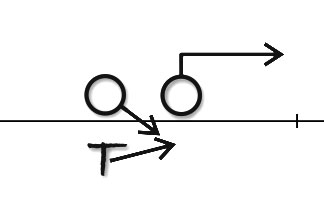
|
Diagram 1
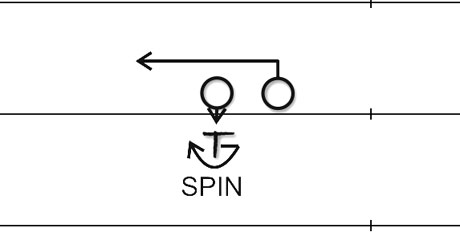
|
Diagram 2
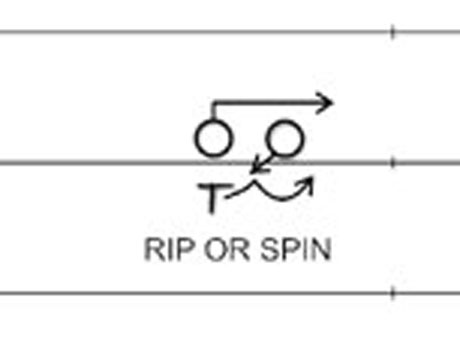
|
Diagram 3
The out tackle drill is set up the same as the blood tackle except that the offensive players are now the offensive tackle and tight end. A backside guard will also be added with a hand shield. The first time through, the offensive tackle and end will cut off and climb and the out tackle will squeeze the backside trap guard (See Diagram 4). The second time through, the tight end and offensive tackle will double- team the out tackle. The out tackle will either stay low and split the double team or spin out of the double team (See Diagram 5).
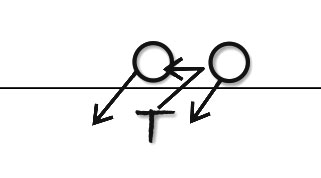
|
Diagram 4
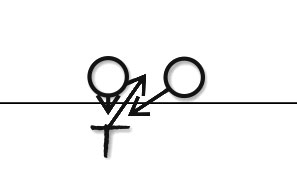
|
Diagram 5
The final drill addresses those few times where we have to play straight up against larger O-linemen. The drill consists of the players using their various tools on the blocking sled. The tools we practice are the rip, swim and spin move.
The practice session finishes up with the entire defensive line lining up against a full offensive line. The offensive line will run various blocking schemes and we work on recognizing those blocking schemes.
In an era where kids have to be entertained, I have chosen to take the opposite approach and do the same very basic fundamental drills every day. I know that I have done my job when the players complain that the drills are boring. This means that the techniques are becoming second nature and my players no longer have to think about them. This equates to Friday night success and a great defense.
Jamie Grime is the Head Football Coach at Delta High School (OH). He can be reached at JamieGrime@GridironStrategies.com.
WHAT IF?
Q1. What if you're facing a Wing-T that uses a lot of motion? Does your angle 50 defense change at all in terms of responsibilities?
We do not change responsibilities because of motion. The front five react to blocking schemes and changing angles can cause confusion. We will look for tendencies though with motion and make minor adjustments if needed. For example, many teams have started running balanced formations at us such as T or Ace. We will wait for them to go in motion and then angle to the motion if the data supports this tendency. Most teams we play either use motion as a decoy or a lead blocker and we will adjust accordingly.
Q2. What if youíre playing a Wing-T team that has a strong sprint out passing offense? Do you make any adjustments with your defensive linemen?
The sprint passing game needs to be stopped by the defensive ends and linebackers in our defense. We anchor our ends every play to prevent offensive players from getting to the edge. During obvious passing downs, we will change the defense and take the angle off to put more pressure on the quarterback with our blitz packages.
Q3. What if youíre in a situation where your nose guard is getting beaten consistently? What changes or adjustments would you make to keep the middle linebacker free?
As noted in the article, this defense is only effective if you have a nose guard that can control his area. One adjustment that could be made would be to kick and reduce the nose guard and the back side tackle over the guards to prevent the double team with the center. Nose Guards must also be taught survival skills. The nose guards best friends are quickness and staying low. I do not ask my nose guards to take on the center chest to chest because I know they are not big enough to handle it. My nose guards know that the center should be blocking their shoulder at the snap of the ball. If you look at their progression, they are always reading the guards blocking scheme first because that down/double block is what can hurt them most. Protection of the middle linebacker is their primary job and this defense is ineffective without a middle linebacker who can run and make plays. Historically speaking, if my nose guard is getting beat consistently, we will not win.
Sign Up for the Play of the Week Newsletter


Subscribe
Login
Renew
Change Address
Customer service